weather.com meteorologists
February's temperatures might trend colder for a time in parts of the United States, then a potential change in the polar vortex could have some impacts on temperatures by March.
The northern tier from the Pacific Northwest to the Great Lakes is expected to be colder than average from February through April, according to an outlook released Thursday by The Weather Company, an IBM Business, and Atmospheric G2. Parts of the northern Rockies and northern Plains from eastern Washington to the western Upper Peninsula of Michigan are forecast to be coldest relative to average during those three months.
On the other hand, a generally warmer-than-average February through April is forecast from the southern Rockies across the South into the mid-Atlantic. Temperatures are expected to be the farthest above average from southern Texas to southwestern Georgia and the Florida Panhandle.
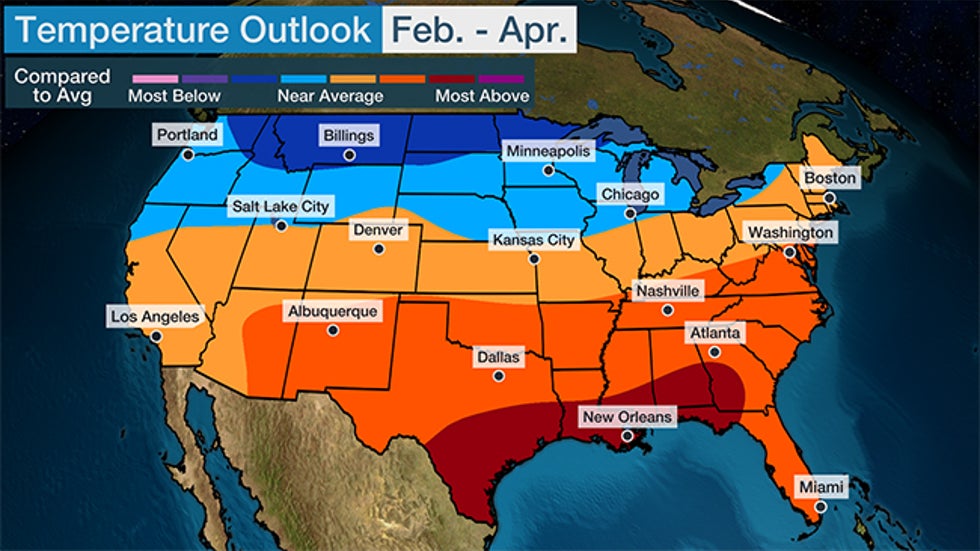
Keep in mind this outlook is an overall trend for February through April. There will be times when areas are warmer or colder than the map above.
Here's a look at the month-by-month outlook and what is driving this forecast:
February
This outlook has trended colder in the West and warmer in the East from the previous version.
Temperatures may be the most persistently below average in the northern Rockies and Great Basin. At least a somewhat chillier February is possible from the West Coast to the upper Midwest.
Much of the East, particularly the Southeast, is expected to have an overall warmer-than-usual February.
While there are indications of expansive colder weather to start the month, that may not last.
"The cold spells over the last few months haven't lasted more than a couple of weeks, so there is no reason to think the upcoming (into early February) cold spell will be different," said Todd Crawford, Vice President of Meteorology at Atmospheric G2.
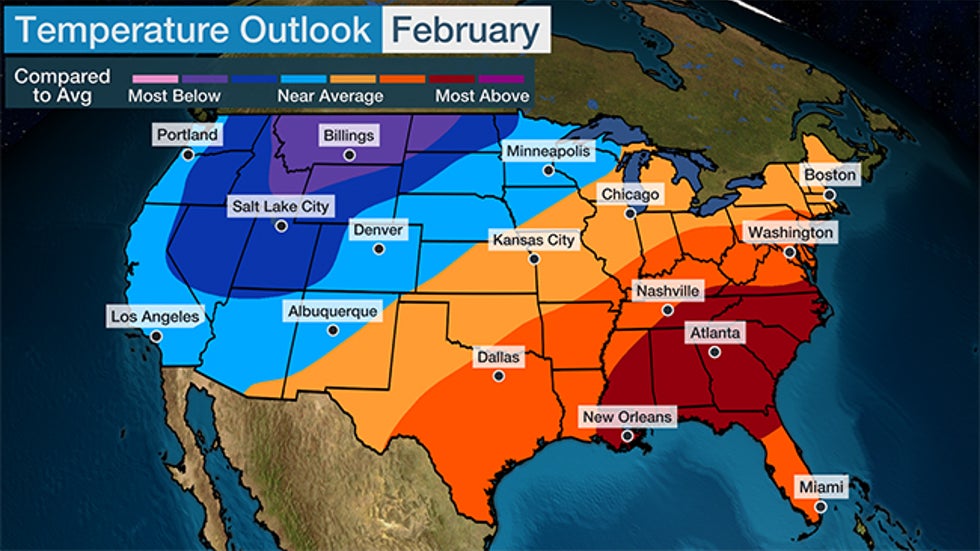
March
This outlook has trended a bit cooler in the Northeast than the previous outlook.
In general, areas from the Pacific Northwest to the interior Northeast could skew at least slightly cooler than average in March. Once again, the northern tier of states from Washington to northern Minnesota is expected to be the coldest relative to average in March.
Meanwhile, the South is still expected to remain milder than usual from the Desert Southwest to the mid-Atlantic. Areas from southern Texas to Georgia, South Carolina and the northern half of Florida are forecast to be farthest above average in March.
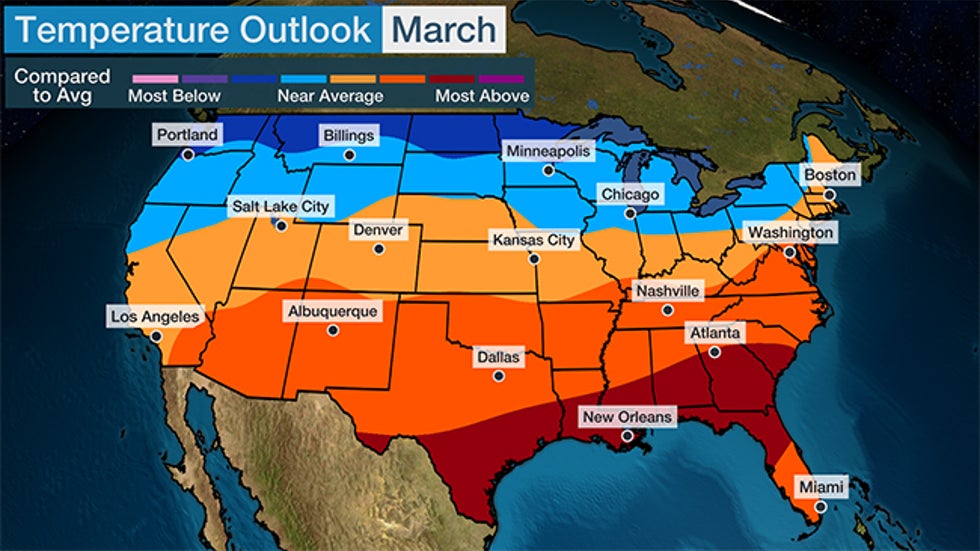
April
April may be a bit frustrating for those itching for springtime warmth in parts of the northern U.S.
The Pacific Northwest, northern Rockies, Northern Plains, upper Mississippi Valley and Great Lakes could shiver through an overall chilly April. The best chance of persistent colder-than-average temperatures is from the plains of eastern Montana and North Dakota across Minnesota, Wisconsin and northern Michigan.
However, spring warmth is likely to be above average in April from the Desert Southwest into the Southeast.
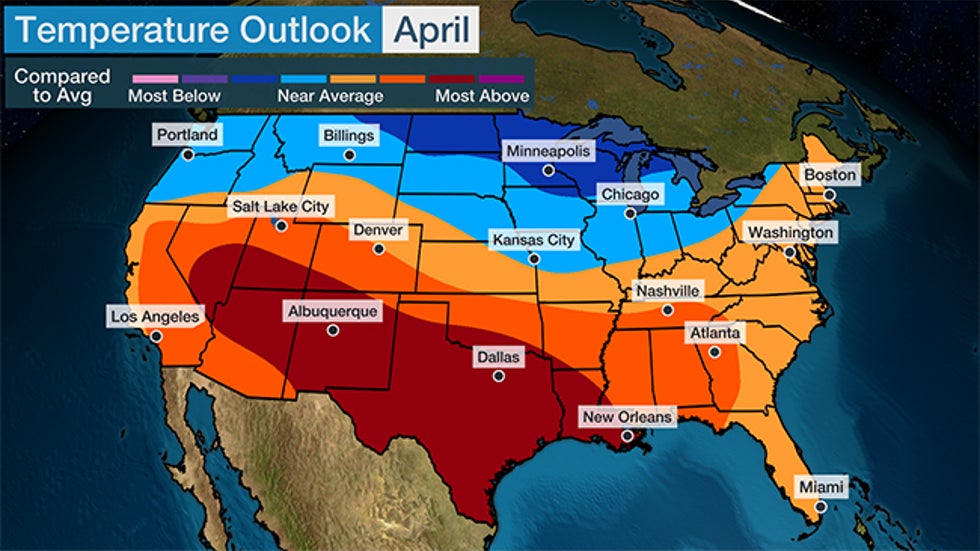
What's Behind The Outlook
Weaker Polar Vortex?
One factor that could contribute to colder weather is the status of the polar vortex.
This whirling cone of low pressure in the stratosphere, well above where most of our weather occurs, has been generally strong early in January. When that happens, the coldest air remains relatively confined in the higher latitudes.
However, as of the time this outlook was issued, computer model forecasts suggested the polar vortex could be weakened by early February due to a sharp warming known as a sudden stratospheric warming (SSW) event.
Assuming that forecast holds, this matters because disruptions in the polar vortex can eventually set up blocking patterns that unleash more widespread cold air deeper into the U.S.
But that could take weeks.
"The potential SSW that everyone is talking about will likely not impact February in any meaningful way," wrote Crawford in the outlook. So we may have to wait until March for any potential impact on temperatures in the U.S.
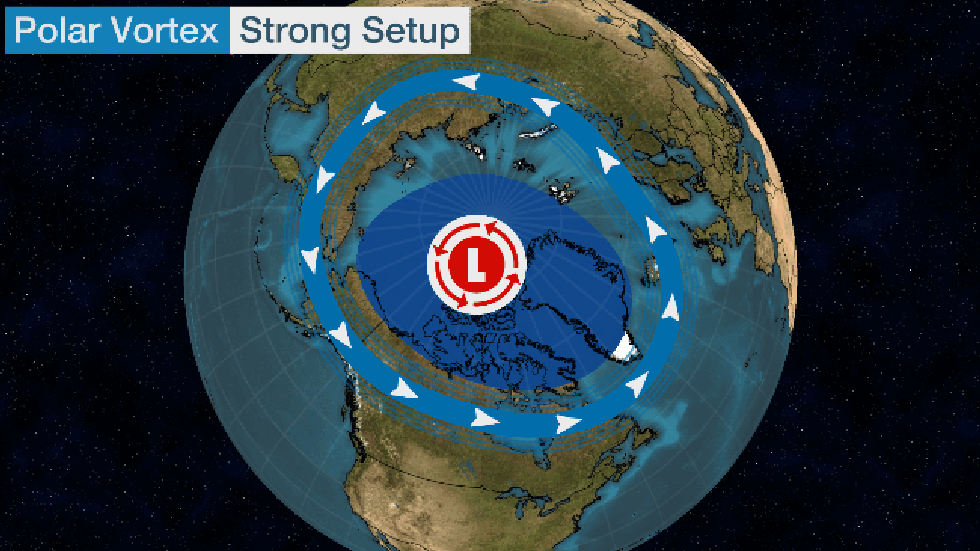 Contrast between a strong stratospheric polar vortex, such as was seen in early January, compared to the forecast for a weak polar vortex and sudden stratospheric warming by early February 2023.
Contrast between a strong stratospheric polar vortex, such as was seen in early January, compared to the forecast for a weak polar vortex and sudden stratospheric warming by early February 2023.La Niña Lingers
Despite the uncertainty regarding the polar vortex, La Niña is still in place for a rare third straight year.
La Niña is the periodic cooling of the equatorial eastern and central Pacific Ocean, and the interaction of this cooler-than-average water with the atmosphere can affect weather conditions around the globe.
The latest forecasts from NOAA's Climate Prediction Center expect La Niña to slowly weaken into spring. It's another factor that could contribute to more persistent cold in the West through March.
But there are also some signals on the milder side.
"Spring is quite warm in the Plains, with cooler-than-normal temperatures confined to the Northeast and Pacific Northwest," Crawford said after examining past springs with a weakening La Niña.
Crawford also said the atmospheric response to La Niña remains relatively weak, which means more variability in this pattern is possible.
The Weather Company’s primary journalistic mission is to report on breaking weather news, the environment and the importance of science to our lives. This story does not necessarily represent the position of our parent company, IBM.
The Weather Company’s primary journalistic mission is to report on breaking weather news, the environment and the importance of science to our lives. This story does not necessarily represent the position of our parent company, IBM.

No comments:
Post a Comment